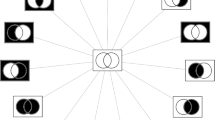Abstract
This paper discusses an expected utility approach on ρ to decision making under incomplete information using the belief function framework. In order to make rational decisions under incomplete information, some subjective assumptions often need to be made because of the interval representations of the belief functions. We assume that a decision maker may have some evidence from different sources about the value of ρ, and this evidence can also be represented by a belief function or can result in a unique consonant belief function that is constrained by the evidence over the same frame of discernment. We thus propose a novel approach based on the two-level reasoning Transferable Belief Model and calculate the expected utility value of ρ using pignistic probabilities transformed from the interval-based belief functions. The result can then be used to make a choice between overlapped expected value intervals. Our assumption is between the strongest assumption of a warranted point value of ρ and the weakest assumption of a uniform probability distribution for an unwarranted ρ.
Preview
Unable to display preview. Download preview PDF.
Similar content being viewed by others
References
Dubois, D., Prade, H.: Possibility theory and data fusion in poorly informed environments. Control and Engineering Practice 2(5), 811–823 (1994)
Shafer, G.: A Mathematical Theory of Evidence. Princeton University Press, Princeton (1976)
Dempster, A.P.: A generalisation of Bayesian inference (with discussion). Journals of the Royal Statistical Society B 30, 205–232 (1968)
Clemen, R.T., Winkler, R.L.: Combining Probability Distributions From Experts in Risk Analysis. Risk Analysis 19(2), 187–203 (1999)
Lesh, S.A.: An evidential theory approach to judgement-based decision making, PhD thesis, Dept. of Forestry and Environmental Studies, Duke University (1986)
Strat, T.M.: Decision Analysis Using Belief Functions. In: Yager, R.R., Fedrizzi, M., Kacprzyk, J. (eds.) Advances in the Dempster-Shafer Theory of Evidence. John Wiley and Sons, New York (1994)
Dubois, D., Prade, H.: On several representations of an uncertain body of evidence. In: Gupta, M.M., Sanchez, E. (eds.) Fuzzy Information and Decision Process, pp. 167–181. North-Holland, Amsterdam (1982)
Nguyen, H.T., Walker, E.A.: On Decision Making Using Belief Functions. In: Yager, R.R., Fedrizzi, M., Kacprzyk, J. (eds.) Advances in the Dempster-Shafer Theory of Evidence. John Wiley and Sons, New York (1994)
Smets, P., Kennes, R.: The transferable belief model. Artificial Intelligence 66, 191–234 (1994)
Schubert, J.: On Pin a Decision-Theoretic Apparatus of Dempster-Shafer Theory. International Journal of Approximate Reasoning 13, 185–200 (1995)
Smets, P.: Decision Making in a Context where Uncertainty is Represented by Belief Functions. In: Srivastava, R., Mock, T.J. (eds.) Belief Functions in Business Decisions, pp. 17–61. Physica-Verlag, Heidelberg (2002)
Dubois, D., Prade, H., Smets, P.: Representing partial ignorance. IEEE System Machine and Cybernetic 26, 361–377 (1996)
Dubois, D., Prade, H.: The principle of minimum specificity as a basis for evidential reasoning. In: IPMU, pp. 75–84 (1986)
Dubois, D., Prade, H., Smets, P.: New semantics for quantitative possibility theory. In: Proceedings of the Second International Symposium on Imprecise Probabilities and Their Applications, Ithaca, NY, USA, pp. 152–161 (2001)
Smets, P.: Probability, Possibility, Belief: Which and Where. In: Gabbay, D., Smets, P., Smets, P. (eds.) Handbook of Defeasible Reasoning and Uncertainty Management Systems. Quantified Representation of Uncertainty and Imprecision, vol. 1, pp. 1–24. Kluwer, Doordrecht (1998)
Dubois, D., Prade, H., Smets, P.: A definition of subjective possibility. Operations Research and Decisions 4, 7–22 (2003)
Author information
Authors and Affiliations
Editor information
Editors and Affiliations
Rights and permissions
Copyright information
© 2005 Springer-Verlag Berlin Heidelberg
About this paper
Cite this paper
Fan, Y., Deer, P. (2005). A New Approach on ρ to Decision Making Using Belief Functions Under Incomplete Information. In: Zhang, S., Jarvis, R. (eds) AI 2005: Advances in Artificial Intelligence. AI 2005. Lecture Notes in Computer Science(), vol 3809. Springer, Berlin, Heidelberg. https://doi.org/10.1007/11589990_47
Download citation
DOI: https://doi.org/10.1007/11589990_47
Publisher Name: Springer, Berlin, Heidelberg
Print ISBN: 978-3-540-30462-3
Online ISBN: 978-3-540-31652-7
eBook Packages: Computer ScienceComputer Science (R0)




